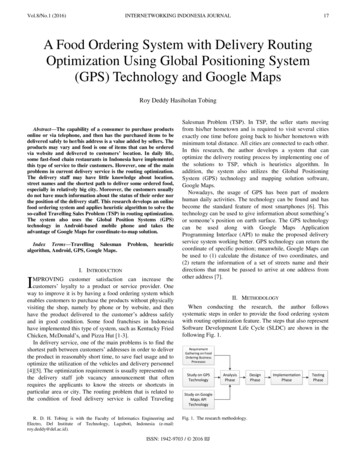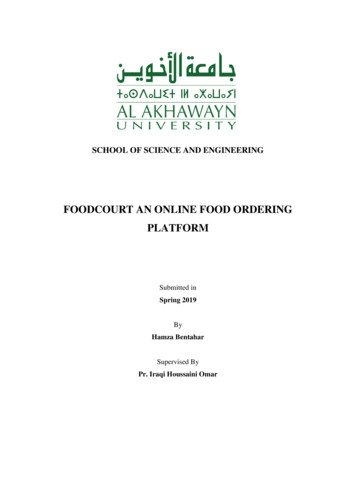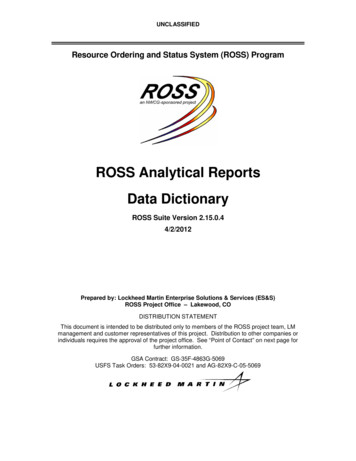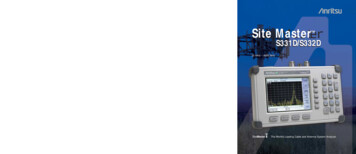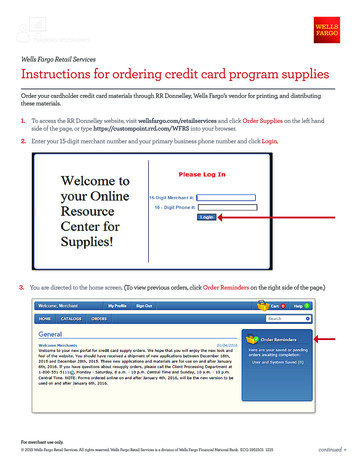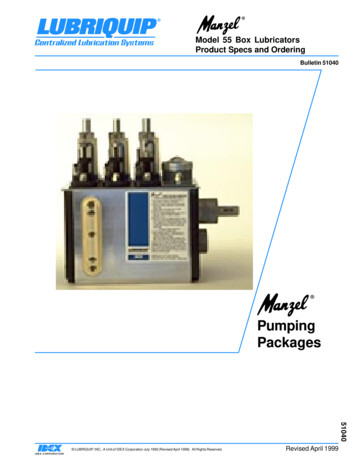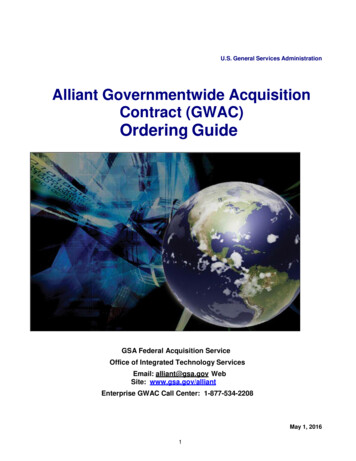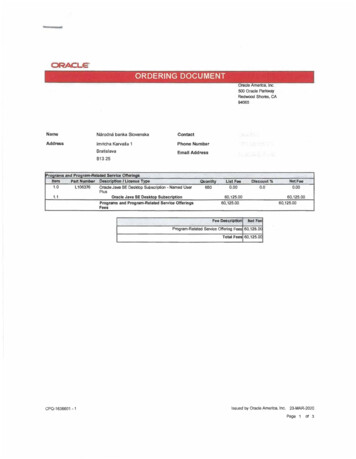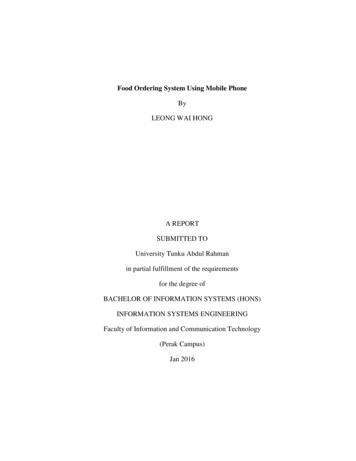
Transcription
Food Ordering System Using Mobile PhoneByLEONG WAI HONGA REPORTSUBMITTED TOUniversity Tunku Abdul Rahmanin partial fulfillment of the requirementsfor the degree ofBACHELOR OF INFORMATION SYSTEMS (HONS)INFORMATION SYSTEMS ENGINEERINGFaculty of Information and Communication Technology(Perak Campus)Jan 2016
DECLARATION OF ORIGINALITYI declare that this report entitled “Food Ordering System using Mobile Phone” is myown work except as cited in the references. The report has not been accepted for anydegree and is not being submitted concurrently in candidature for any degree or otheraward.Signature :Name : LEONG WAI HONGDate : 20 APRIL 2016BIS (Hons) Information Systems EngineeringFaculty of Information and Communication Technology (Perak Campus), UTAR.ii
ACKNOWLEDGEMENTFirst of all, I would like to express a deeply thank to my supervisor, Mr. Ku Chin Soonfor his demonstration of guidance, giving useful advice, conceptualize the project whichenabled me to have clear understanding of my final year project. Lastly, I would like tothanks again to my final year project super visor and whoever has guided me most of thetime and supported me throughout the project.BIS (Hons) Information Systems EngineeringFaculty of Information and Communication Technology (Perak Campus), UTAR.iii
ABSTRACTThe purpose of this project is to develop a computerized and mobilized food orderingsystem that can be used to revolutionize the traditional ordering system that currentlyimplemented in majority of the food and beverage industry. The traditional system thatusing by most of the food and beverage industry is the traditional manual ordering systemwhich means all works and procedures is recorded through manpower manual work andit consist of a huge amount of paper work that is not effective and efficiency. This causethe business to encounter trouble which regarding human error due to the huge amount ofmanpower manual work that operating in each business routine. Thus, this computerizedand mobilized food ordering system is designed to assist the business routine in term ofhaving better management as well as easier to handle daily business operation.This system is designed for small medium enterprise food and beverage industry. Thechosen methodology for this project is throwaway prototyping methodology. This isbecause majority of the targeted user do not have the experience in using computerizedsystem in food ordering procedure as they implement traditional ordering systempreviously. Therefore, this methodology enables developer to communicate with targetuser through using the prototyping, which can let target user to review, evaluate, visualizeand learn about the system before the actual implementation of the final system.Furthermore, the system is a cross platform system which involve desktop based andmobile phone based which is in Android operating system. It is also the highlightedfeature of the system which does not limited the ordering procedures to desktop based asportable and mobility is the current trend. Besides that, with this feature it also provide adegree of level of self service for targeted users’ consumers, as they can place orderthemselves through using the mobile application.BIS (Hons) Information Systems EngineeringFaculty of Information and Communication Technology (Perak Campus), UTAR.iv
Table of ContentsTable of ContentsLIST OF FIGURES . viiiCHAPTER 1 INTRODUCTION . 11.1 Project Overview. 11.2 Project Background. 11.3 Problem Domain . 21.4 Project Objectives . 41.4.1 Provide convenience for both employees and consumers . 41.4.2 Assist restaurant to plan ahead . 41.4.3 Prevention of food serves not in sequence . 41.5 Project Scope . 61.6 Impact, Significance and Contribution . 71.7 Chapter Summary . 8CHAPTER 2 LITERATURE REVIEW . 92.1 Wireless Food Ordering System . 92.2 Online Ordering System . 122.3 Electronic Menu Card for Restaurants . 152.4 Chapter Summary . 17CHAPTER 3 METHODOLOGY . 183.1 Proposed Methodology . 183.1.1 Planning & Analysis . 193.1.2 Analysis, Design & Implementation of prototype . 193.1.3 Design Prototype . 193.1.4 Design . 193.1.5 Implementation . 203.2 System Planning. 203.2.1 Project Timeline . 213.3 System Analysis . 233.3.1 Functional Requirements . 233.3.2 Non Functional Requirements . 243.3.3 Hardware & Software Requirements . 25BIS (Hons) Information Systems EngineeringFaculty of Information and Communication Technology (Perak Campus), UTAR.v
Table of Contents3.3.4 Use Case Diagram. 273.3.5 Activity Diagram . 283.3.6 Class Diagram . 403.3.7 Object Diagram . 41CHAPTER 4 SYSTEM DESIGN ON FOOD ORDERING SYSTEM USING MOBILE PHONE . 424.1 Project Design . 424.2 Graphic User Interface Design . 424.2.1 Computer Side . 424.2.2 Mobile Phone Side . 564.3 Database Design/Entity Relationship Diagram (ERD) . 604.4 System Architecture Design . 61CHAPTER 5 SYSTEM TESTING . 625.1 Project Implementation & Testing . 625.2 Implementation Issues & Challenges . 625.3 Development Tools . 635.3.1 Database Environment . 635.3.2 Web Technology . 635.3.3 System Platform . 635.3.4 Project Management Tool . 645.3.5 Visual Paradigm Community Edition . 645.3.6 NetBean IDE and Android Studio IDE . 645.4 Test Plan . 645.4.1 Unit Testing . 655.4.2 Functional Testing . 715.4.3 System Testing . 785.4.4 Acceptance Testing . 78CHAPTER 6 SYSTEM EVALUATE AND DISCUSSION . 796.1 Proposed System Completion . 796.2 System Strength and Limitation. 806.2.1 System Strength . 806.2.2 System Limitation . 806.3 Future Enhancement . 80BIS (Hons) Information Systems EngineeringFaculty of Information and Communication Technology (Perak Campus), UTAR.vi
Table of ContentsCHAPTER 7 CONCLUSION . 82REFERENCES . 83APPENDIX A USE CASE DESCRIPTION . 85BIS (Hons) Information Systems EngineeringFaculty of Information and Communication Technology (Perak Campus), UTAR.vii
List of FiguresLIST OF FIGURESFigure 1 Logical Wireless Diagram . 10Figure 2 Context Level Data Flow Diagram of Online Order System . 13Figure 3 Entire Process Flow of Electronic Menu Card System . 16Figure 4 Diagram of Throwaway Prototyping processes . 18Figure 5 Timeline for Project 1 . 21Figure 6 Timeline for Project 2 . 21Figure 7 Timeline for Project 2 (cont) . 21Figure 8 Project Timeline . 22Figure 9 Use Case Diagram . 27Figure 10 Activity Diagram for Place Order using Mobile Phone . 28Figure 11 Activity Diagram for Generate Report . 29Figure 12 Activity Diagram for Update Menu Info . 30Figure 13 Activity Diagram for Validate Order. 31Figure 14 Activity Diagram for View Order Queue .
system in food ordering procedure as they implement traditional ordering system previously. Therefore, this methodology enables developer to communicate with target user through using the prototyping, which can let target user to review, evaluate, visualize and learn about the system before the actual implementation of the final system.
